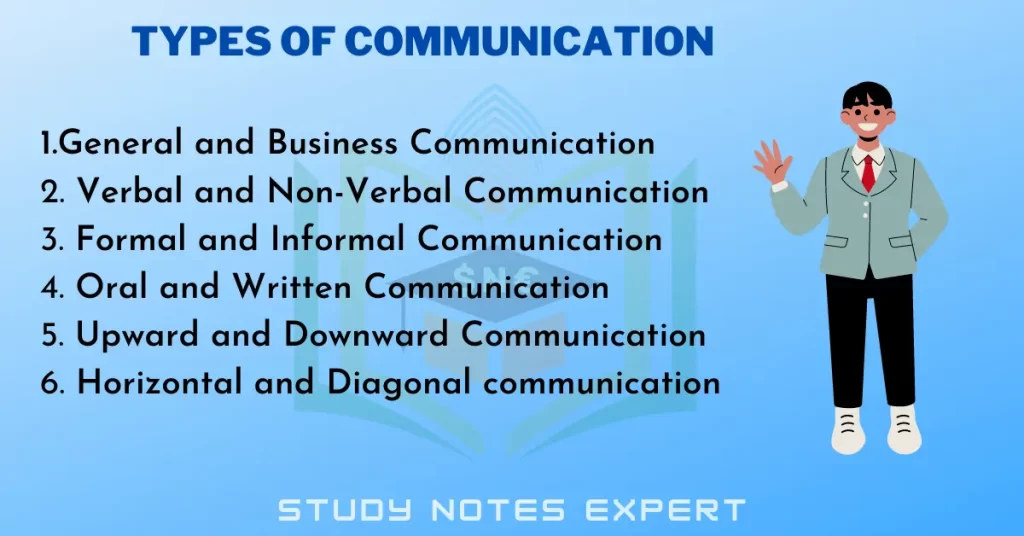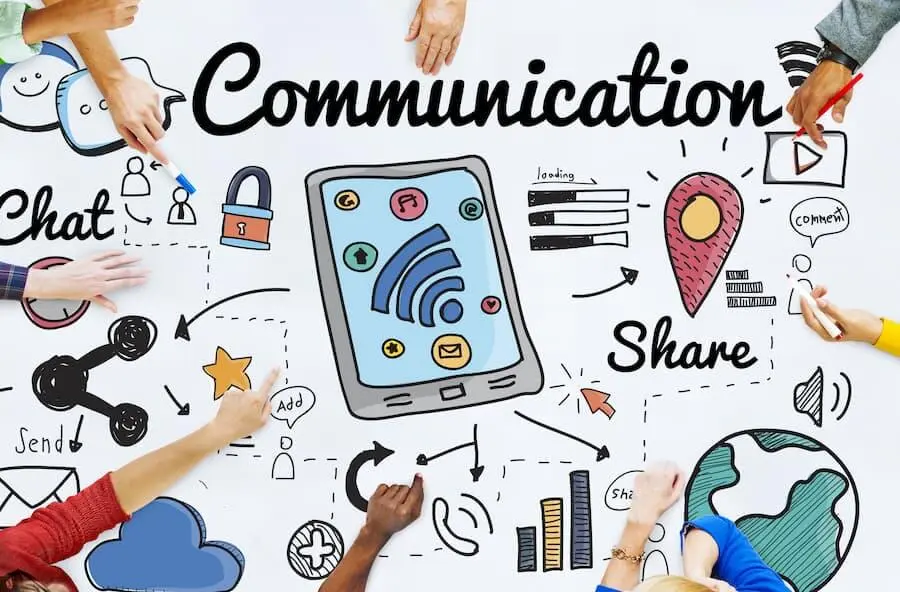In this article, we will discuss the difference between types of communication such as:

Difference between Different Types of Communication

Difference between General and Business Communication
General Communication
- General Communication is all sorts of sending & receiving messages.
- It plays many roles in the world at large.
- It can be a simple exchange of ideas, facts or information.
- It can be non-linguistic, using symbols such as traffic lights, road signs, etc. We are communicated.
Business Communication
- Business Communication is a specialized branch of general Communication.
- It is mainly concerned with business activities.
- The purpose of this communication is very well defined. It is one of the types of communication.
- It is an art where language plays a significant role.
Difference between Verbal and Non-Verbal Communication
Verbal Communication
- Verbal Communication is more natural & immediate.
- Needs more training & practice speaking in a formal situation.
- Requires no understanding of things pre-hand. If he is a compelling speaker, he makes his point clear.
- Verbal communication demands attention and needs the personal presence of both speaker & the listener.
- It is knowledge-based, requiring little skill to understand the message delivered.
Non-Verbal/Visual Communication
- It occurs when there is no verbal communication.
- Requires knowledge of the use of signs & symbols.
- Humans respond more powerfully to pictures and quickly grasp this method. It is one of the types of communication. Graphs & pictures are necessary for conveying ideas.
- It always accompanies verbal communication, whether oral or written, for it ‘speaks louder than words’.
- It is perceived through the senses, tailor-made for illiterates.
Difference between Formal and Informal Communication
Formal Communication
- It is a slow-moving process(speed).
- It is easy to pinpoint responsibility concerning formal communication(responsibility).
- Formal communication follows the officially established chain of command and lines of communication (authority).
- It is task-oriented (focus).
- It consists mainly of work-related matters(pattern).
- It is orderly and systematic as regards the direction of flow(direction).
- It serves organizational needs. (service)
- It flows in a vertical, horizontal and diagonal direction(flow).
- It can be oral & written form(form).
- The message is accurate and authentic(authenticity).
- The channels are preplanned(channels).
Informal Communication
- Informal Communication is independent of the authority relations in the organization.
- It carries massage at a fast speed.
- It is not possible to fix the responsibility of informal communication.
- It is people-oriented.
- It may consist of work-related as well as social messages.
- It needs to be more systematic and erratic as regards the direction of flow.
- It is primarily oral.
- It serves not only organisational needs but also the social needs of people.
- It can flow in every possible direction.
- The message can’t be considered authentic unless formal channels supplement it.
- The channels are not preplanned.
Difference between Oral and Written Communication
Oral Communication
- Communication is expressed through spoken words
- It takes less time
- It may need to be more precise.
- Oral communication may need to be completed. It is one of the types of communication. It may be challenging toh understand it.
- It is generally informal.
- The verbal message may be taken casually.
- The verbal message may not be verifiable.
- Most oral communication is temporary.
- Oral communication is effective only when the receiver has practical listening skills.
- Oral communication does not require paperwork.
- Oral communication does not have legal validity.
- In oral communication, the speaker can have quick feedback.
- The role of body language is crucial in oral communication.
- Oral communication does not involve using advanced technology like fax or e-mail.
Written Communication
- Communication is expressed in writing.
- It takes more time.
- It can be exact.
- Written communication is easy to understand if expressed in unambiguous terms.
- It is generally formal.
- It is generally taken seriously.
- A written message is verifiable from the records.
- Written communication is permanent.
- There is no such precondition for written communication.
- Written communication requires paperwork.
- Written communication has legal validity.
- In written communication, the writer or sender needs to have the advantage of quick feedback.
- There is no role in body language communication.
- Written communication can effectively use electronic systems like computer systems, teleprinters, e-mail, fax, and e-commerce.
Difference between Upward and Downward Communication
Upward Communication
- The flow of information from lower to higher level authority(flow).
- It is the source of motivation for employees(motivation).
- Reports, suggestions, Appeals, grievances Appealing and informative.
- To provide feedback(purpose).
- slow(speed)
Downward Communication
- The flow of information from higher to lower levels of authority.
- It is not a source of motivation for employees.
- Orders, Notices, Circulars and instructions.
- Directive and authoritative
- Fast-to-implement plans
Difference between Horizontal and Diagonal communication
Lateral or Horizontal Communication
- The flow of information between persons working at the same level of authority.
- Action is slow because of the interdepartmental boss meeting.
- It creates mutual understanding.
- It develops cooperation and coordination among managers.
Diagonal or Crosswise Communication
- The flow of information between persons of a lower level and a higher level of different departments.
- It speeds up action.
- It may cause communication conflicts and confusion.
- It helps coordination but creates anarchy.
Conclusion
Now, you will gain knowledge regarding the different types of communication. These will help in better understanding of the events and organizational planning. Better communication will improve the position of the organization. Every type of communication will help in improvement. Downward communication will provide the information to the lower levels.

